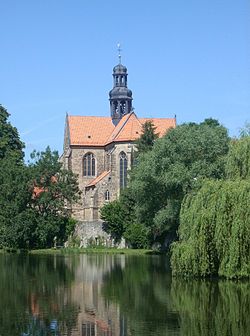Marienrode Monastery
| Benedictine priory Marienrode | |
|---|---|
 Mill pond and St. Michael monastery church |
|
| location |
Lower Saxony |
| Coordinates: | 52 ° 6 '50.2 " N , 9 ° 54' 51.5" E |
| Serial number according to Janauschek |
639 |
| Patronage | St. Mary |
| founding year | 1125/1259 |
| Year of dissolution / annulment |
1806 |
| Year of repopulation | 1988 |
| Mother monastery | St. Hildegard (Eibingen) |
|
Daughter monasteries |
no |
The monastery Marienrode is a company founded in 1125 in the monastery at Hildesheim belonging locality Neuhof / Hildesheim Forest / Marienrode .
history
The Marienrode monastery near Hildesheim was founded on May 22nd, 1125 by the Hildesheim bishop Berthold I von Alvensleben in the former settlement of Baccenrode (Latin: Novale Bacconis ). “Novale” means arable land that is to be cultivated or has already been cultivated, for example Neubruch , so the first settler could have been called Bacco. It existed until 1259, initially as an Augustinian monastery , later as a subsidiary of Riddagshausen Monastery from the filiation of the Morimond primary abbey as a Cistercian monastery. The Cistercians gave the place the name Marienrode, which is still in use today, after Bishop Johann I von Brakel expelled the monks and nuns of the Backenroth monastery in 1259 due to moral decline. The Cistercians gave the monastery a new name: Monasterium Novalis sanctæ Mariæ .
"After Franziscus Borsums chronicle of Hannover " ran the monastery already in 1250 a branch in Hanover , the until the Reformation operated Marie Roeder yard .
After the secularization of 1806, the domain came into the possession of the Kingdom of Westphalia under Jérôme Bonaparte in 1807 , was leased to the Calenberg clerk Süllow and bought in 1811 by the royal Westphalian finance minister Carl August von Malchus (from 1813 title Graf von Marienrode ). After the Battle of the Nations near Leipzig , Elector (later King) Georg III. from Hanover the domain in 1813 to Lieutenant General and Chief Forester Carl Baron von Beaulieu-Marconnay . He was married to Henriette Countess von Egloffstein (1774–1864) since 1804 . She and three daughters from her first marriage, Caroline, Julie , Auguste, who belonged to the Weimar Circle around Johann Wolfgang von Goethe , are lying in a shared grave near the western approach to the former estate. The baron died in 1855. After that there were a number of other tenants. The garden-like terrain near the grave of Countess Egloffstein was used as a cemetery for Russian and Polish slave laborers during the Third Reich . The grave of the Polish chaplain was reburied in the 1960s and can be seen in the Catholic cemetery. The remaining, partly Orthodox grave sites were leveled on behalf of the Catholic church council .
Marienrode was administered from 1818 to 1850 by the local lawyer Christian Eberhard Meyer (* 1777, † July 14, 1850 in Marienrode), who was also buried here . He was since May 2, 1795 at the University of Göttingen , 1800 official auditor in Osterode am Harz , 1803 there clerk, 1806 in Uslar , 1809 justice of the peace in Osterode, 1814 official assessor in 1814 Burgdorf and was last in 1818 Oberamtmann in Marienrode . He married the local lawyer daughter Antoinette Kern on November 30, 1809 in Osterode.
After 1945, some manor buildings were used to house displaced persons from Silesia and East Prussia , some of whom lived there until the monastery was founded. Since the beginning of his term of office in 1983, the Hildesheim Bishop Josef Homeyer tried to settle new monasteries in the Diocese of Hildesheim and so the Marienrode Monastery was repopulated on May 5, 1988 by Benedictine nuns from the St. Hildegard Abbey in Eibingen , after the previous residents and the tenants of the estate were urged to move out in 1986. In 1998 Marienrode became an independent priory ; the monastery belongs to the Beuron congregation . In 2014 Sr. Mirjam Zimmermann succeeded her predecessor Maria Elisabeth Bücker as Prioress.
Marienrode today

The Catholic parish church of St. Michael belongs to the monastery . There is also a smaller Protestant parish church of St. Cosmas and Damian, a former pilgrimage church, on the edge of the monastery grounds in Marienrode . To the east of the monastery is the Marienrode cemetery.
According to the popular short version of Benedictine life Ora et labora , everyday life is structured by common prayer times. The Marienrode sisters run a retreat and guest house run by the Diocese of Hildesheim , run a book and art shop and perform sexton and organist services in the church, which is also the parish church. Your convent adjoins the St. Michael church to the north as a three-wing complex and encloses a simple cloister courtyard . The cloister gate, like the second baroque portal of the west wing, is adorned with a chronogram .
See also
literature
- Helmut von Jan: 850 years of Marienrode Abbey. Publishing house Gebrüder Gerstenberg, Hildesheim 1975, ISBN 3-8067-8017-X .
- Wilfried Meyer (Ed.): Marienrode. Present and history of a monastery. Bernward Verlag, Hildesheim 1988, ISBN 3-87065-445-7 .
- Open to God - open to life. The Marienrode Benedictine Monastery. Verlag Schnell & Steiner, 2003, ISBN 3-7954-1650-7 .
- Helmut von Jan: Bishop, City and Citizen. Essays on the history of Hildesheim. Bernward, Hildesheim 1985, ISBN 3-87065-375-2 .
Web links
- Homepage of the Marienrode monastery
- Homepage of the St. Hildegard Abbey, Eibingen
- Marienrode at www.cistercensi.info
Individual evidence
- ^ Arnold Nöldeke : Marienröder Hof. In: The art monuments of the province of Hanover. Vol. 1, H. 2, Part 1, Hanover, self-published by the Provinzialverwaltung, Theodor Schulzes Buchhandlung, 1932 (Neudruck Verlag Wenner, Osnabrück 1979, ISBN 3-87898-151-1 ), p. 225.
- ^ Greetings from Königsmünster Abbey , 2015 Annual Report, p. 68.
- ↑ Marienroder Chronograms

